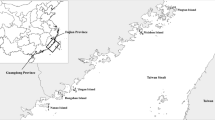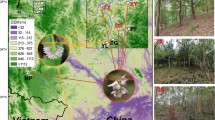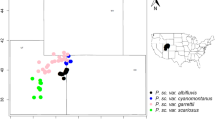Abstract
Magnolia odoratissima is a highly threatened species, with small distribution and scattered populations due to habitat fragmentation and human activity. In this study, the genetic diversity and population structure of the five remaining natural populations and two cultivated populations of M. odoratissima were analyzed using single nucleotide polymorphisms (SNPs) derived from specific-locus amplified fragment sequencing. A total of 180,650 SNPs were identified in seventy M. odoratissima individuals. The Nei’s and Shannon-Wiener diversity index across all M. odoratissima population were 0.35 and 0.51, respectively, while the observed heterozygosity (Ho) and expected heterozygosity (He) were 0.27 and 0.34, respectively. Our results suggest that M. odoratissima has relatively high genetic diversity at the genomic level. The FST and AMOVA indicated that high genetic differentiation exists among populations, and a phylogenetic neighbor-joining tree, Bayesian model–based clustering and discriminant function analysis of principal component all divided the M. odoratissima individuals into three distinct clusters. The Treemix analysis showed that there was low gene flow among the natural populations. Demographic history inferences indicated show that three clusters of M. odoratissima experienced at least three bottlenecks and resulted in a decrease of effective population size. Our results suggest that three distinct evolutionary significant units should be set up to conserve this critically endangered species.





Similar content being viewed by others
Data availability
The sequencing data of 70 samples from this study is currently being submitted to NCBI Sequence Read Archive (https://www.ncbi.nlm.nih.gov/sra) under the BioProject accession PRJNA777447 with Run accession numbers from SRR16888350 to SRR16888419.
References
Alexander DH, Novembre J, Lange K (2009) Fast model-based estimation of ancestry in unrelated individuals. Genome Res 19:1655–1664. https://doi.org/10.1101/gr.094052.109
Allen GC, Flores VMA, Krasynanski S, Kumar S, Thompson WF (2006) A modified protocol for rapid DNA isolation from plant tissues using cetyltrimethylammonium bromide. Nat Protoc 1:2320–2325. https://doi.org/10.1038/nprot.2006.384
Audigeos D, Buonamici A, Belkadi L, Rymer P, Boshier D, Scotti-Saintagne C, Vendramin GG, Scotti I (2010) Aquaporins in the wild: natural genetic diversity and selective pressure in the PIP gene family in five neotropical tree species. BMC Evol Biol 10:202. https://doi.org/10.1186/1471-2148-10-202
Beichman AC, Huerta-Sanchez E, Lohmueller KE (2018) Using genomic data to infer historic population dynamics of nonmodel organisms. Annu Rev Ecol Evol Syst 49:433–456. https://doi.org/10.1146/annurev-ecolsys-110617-062431
Budd C, Zimmer E, Freeland JR (2015) Conservation genetics of Magnolia acuminata, an endangered species in canada: can genetic diversity be maintained in fragmented, peripheral populations? Conserv Genet 16:1359–1373. https://doi.org/10.1007/s10592-015-0746-9
Bus A, Hecht J, Huettel B, Reinhardt R, Stich B (2012) High-throughput polymorphism detection and genotyping in Brassica napus using next-generation RAD sequencing. BMC Genom 13:281. https://doi.org/10.1186/1471-2164-13-281. https://doi.org/10.1186/1471-2164-13-281
Chang YL, Peng MW, Chu GM, Wang M (2020) Genome wide assessment of population structure and genetic diversity for Anabasis aphylla based on specific length amplification fragment sequencing. J Plant Int 15:75–82. https://doi.org/10.1080/17429145.2020.1750096
Chávez-Cortázar A, Oyama K, Ochoa-Zavala M, Mata-Rosas M, Quesada M (2021) Conservation genetics of relict tropical species of Magnolia (section macrophylla). Conserv Genet 22:259–273. https://doi.org/10.1007/s10592-021-01334-5
Chen LY, Chen FJ, He SC, Ma LY (2014) High genetic diversity and small genetic variation among populations of Magnolia wufengensis (Magnoliaceae), revealed by ISSR and SRAP markers. Electr J Biotechnol 17:268–274. https://doi.org/10.1016/j.ejbt.2014.08.003
Chen S, Huang Z, Yi D, Qin S, Gao Y, Zhang L, Yong G, Chen J (2013) The development of 7E chromosome-specific molecular markers for Thinopyrum elongatum based on SLAF-seq technology. PLoS ONE 8(6):e65122. https://doi.org/10.1371/journal.pone.0065122
Chen SY, Han Y, Wu T, Fu YP, SiMa YK, Hao JB (2010) Genetic diversity of endangered species Manglietia grandis detected by inter-simple sequence repeat markers (in chinese). J For Envir 30:56–60
Chun L, Bo S, Quangsheng Y, Hongxia W, Wentian X, Songbiao W (2016) Construction of a high-density genetic map based on large-scale marker development in mango using specific-locus amplified fragment sequencing (SLAF-seq). Front Plant Sci 7:393. https://doi.org/10.3389/fpls.2016.01310
Cristofari R, Liu X, Bonadonna F, Cherel Y, Pistorius P, Maho YL, Paybaud V, Stenseth NC, Bohec CL, Trucchi E (2018) Climate-driven range shifts of the king penguin in a fragmented ecosystem. Nat Clim Chang 8:245–251. https://doi.org/10.1038/s41558-018-0084-2
Delourme R, Piel N, Horvais R, Pouilly N, Domin C, Vallée P, Falentin C, Manzanares-Dauleux MJ, Renard M (2008) Molecular and phenotypic characterization of near isogenic lines at QTL for quantitative resistance to Leptosphaeria maculans in oilseed rape (Brassica napus L.). Theor Appl Genet 117:1055–1067. https://doi.org/10.1007/s00122-008-0844-x
Dong L, Liu XQ, Yu DH, Chai Y (2010) A preliminary study on community characteristics of Magnolia odoratissima, a critically endangered species in Yunnan Province (in chinese). J Anhui Agr Sci 38:12068–12069
Dray S, Dufour A-B (2007) The ade4 Package: implementing the duality diagram for ecologists. J Stat Softw 22:i04. https://doi.org/10.18637/jss.v022.i04
Elshire RJ, Glaubitz JC, Sun Q, Poland JA, Kawamoto K, Buckler ES, Mitchell SE (2011) A robust, simple genotyping-by-sequencing (GBS) approach for high diversity species. PLoS ONE 6:e19379. https://doi.org/10.1371/journal.pone.0019379
Excoffier L, Laval G, Schneider S (2007) Arlequin (version 3.0): an integrated software package for population genetics data analysis. Evol Bioinform Online 1:47–50. https://doi.org/10.1177/117693430500100003
Hamrick JL, Godt MJW (1996) Effects of life history traits on genetic diversity in plant species. Phil Trans R Soc Lond B 35:11291–11298. https://doi.org/10.1098/rstb.1996.0112
Hamrick JL, Loveless MD (1992) Factors influencing levels of genetic diversity in woody plant species. New For 6:95–124. https://doi.org/10.1007/978-94-011-2815-5-7
He SL, Wang ZY, Wang W, Yang Y (2018) Research on population of Magnolia odoratissima Law et R. Z. Zhou, a wild plant species with extremely small populations (in Chinese). J W CN Fore Sci 47:64–68
He SL, Zhang T, Wang W, Yang Y (2020) Seed dormancy and germination of Magnolia odoratissima, a wild plant with extremely small population (in Chinese). Agr Sci Jiangsu 48:133–136
Hernández M, Palmarola A, Veltjen E, Asselman P, Testé E, Larridon I, Samain M-S, González-Torres LR (2020) Population structure and genetic diversity of Magnolia cubensis subsp. acunae (Magnoliaceae): effects of habitat fragmentation and implications for conservation. Oryx 54:451–459. https://doi.org/10.1017/S003060531900053X
Huang JX, Zhuang XY (2002) Genetic diversity of the populations of Tsoongiodendron odorum (in Chinese). Chin J Plant Ecol 4:413–419
Hyten DL, Cannon SB, Song Q, Weeks N, Fickus EW, Shoemaker RC, Specht JE, Farmer AD, May GD, Cregan PB (2010) High-throughput SNP discovery through deep resequencing of a reduced representation library to anchor and orient scaffolds in the soybean whole genome sequence. BMC Genom 11:38. https://doi.org/10.1186/1471-2164-11-38
Jiang JM, Teng HJ, Yuan JL, Luan QF, Tan ZF (2005) Genetic diversity of Michelia chapensis dandy populations (in Chinese). For Res 2:109–113
Jiang WB, Cao J, Li G, Wong ML (2005) Development of new ornamental tree species of Magnolia family in China and its application in landscaping (in Chinese). Acta Agr Shanghai 2:68–73
Jin R, Shi YX, Xu T, Yang MJ, Sima YC, Yang MZ, Sima YK (2014) Study on genetic diversity of endangered and endemic plant of Magnolia odoratissima (Magnoliaceae) in Yunnan Province. J West China Fores Sci 6:80–84
Jin ZX, Li JM (2007) ISSR analysis on genetic diversity of endangered relic shrub sinocalycanthus chinensis (in Chinese). Chin J Appl Ecol 2:247–253
Jombart T, Ahmed I (2011) Adegenet 1.3-1: new tools for the analysis of genome-wide SNP data. Bioinformatics 27:3070–3071. https://doi.org/10.1093/bioinformatics/btr521
John FO (2013) conservation: unmet challenges and the role of the International Primatological Society. Int J Primatol 34:234–245. https://doi.org/10.1007/s10764-013-9664-1
Kent WJ (2002) Blat—The blast-like alignment tool. Genome Res 12:656–664. https://doi.org/10.1101/gr.229202
Khan S, Nabi G, Ullah MW, Yousaf M, Manan S, Siddique R, Hou H, Cao HX (2016) Overview on the role of advance genomics in conservation biology of endangered species. Int J Genom. https://doi.org/10.1155/2016/3460416
Kohn CV, Conr Ad K, Kramer M, Pooler M (2018) Genetic diversity of Magnolia ashei characterized by SSR markers. Conserv Genet. https://doi.org/10.1007/s10592-018-1065-8
Korneliussen TS, Albrechtsen A, Nielsen R (2014) ANGSD: analysis of next generation sequencing data. BMC Bioinform 15:356. https://doi.org/10.1186/s12859-014-0356-4
Kozich JJ, Westcott SL, Baxter NT, Highlander SK, Schloss PD (2013) Development of a dual-index sequencing strategy and curation pipeline for analyzing amplicon sequence data on the MiSeq Illumina sequencing platform. Appl Environ Microbiol 79:5112–5120. https://doi.org/10.1128/AEM.01043-13
Laurent E, Guillaume L, Stefan S (2007) Arlequin (version 3.0): an integrated software package for population genetics data analysis. Evol Bioinform Online 1:47–50. https://doi.org/10.1177/117693430500100003
Li H, Bob H, Alec W, Tim F, Jue R, Nils H, Gabor M, Goncalo A, Richard D (2009) The sequence alignment/map format and samtools. Bioinformatics 25:2078–2079. https://doi.org/10.1093/bioinformatics/btp352
Li YY, Li DX, Mao YL, Li J, Xu JH (1996) Study on extraction and chemical constituents of extract and essential oil from aromatic plants of Yunnan Orchidaceae (in Chinese). Flav Fragr Cosmet 3:2–8
Li YY, SiMa YK, Fang B, Guo LQ, Jiang H, Zhao WS (2003) Current situation and evaluation of natural resources of the priority protection wild plants in Yunnan Province of China (in Chinese). Acta Botanica Yunnanica 25(2):181–191
Liao WF, Xia NH, Deng YF, Zheng QY (2004) Study on genetic diversity of Manglietia decidua (Magnoliaceae) (in Chinese). Plant Divers 1:58–64
Liu DY, Chu L, Yang YH (2004) Genetic diversity of the rare and endangered plant Magnolia amoena (in Chinese). Chin J Appl Ecol 7:1139–1142
Liu K, Li KX, Wei XJ, Liang WH, Wang K (2019) Development and genetic analysis on SNP sites from Camellia nitidssima based on SLAF-seq technology (in Chinese). Non-wood For Res 37:78–83
Lopez -ADM, Bock BC, Bedoya (2008) Genetic structure in remnant populations of an endangered Andean Magnolia. Biotropica 40:375–379. https://doi.org/10.1111/j.1744-7429.2007.00387.x
Loveless DM, Hamrick LJ (1984) Ecological determinants of genetic structure in plant populations. Annu Rev Ecol Syst 15:65–95. https://doi.org/10.1111/j.1365-294X.2010.04688.x
Lowe WH, Allendorf FW (2010) What can genetics tell us about population connectivity? Mol Ecol 19:3038–3051. https://doi.org/10.1111/j.1365-294X.2010.04688.x
Lu RS, Chen Y, Tamaki I, Sakaguchi S, Ding YQ, Takahashi D, Li P, Isaji Y, Chen J, Qiu YX (2020) Pre-quaternary diversification and glacial demographic expansions of Cardiocrinum (Liliaceae) in temperate forest biomes of Sino-Japanese Floristic Region. Mol Phylogenet Evol. https://doi.org/10.1016/j.ympev.2019.106693
Lu YZ, Dong XY, Huang LB, Zheng JW, He XD, Sun HN, Jiang ZP (2020b) SLAF-seq uncovers the genetic diversity and adaptation of Chinese Elm (Ulmus parvifolia) in Eastern China. Forests 11:80. https://doi.org/10.3390/f11010080
Luo GZ, Shi JS, Yin TM, Huang MR, Wang MX (2000) Comparison of genetic diversity between Liriodendron tulipifera Linn. and Liriodendron chinense (Hemsl) Sarg. by means of RAPD markers (in Chinese). J Plant Res Env 9(2):9–13
Ma YP, Chen G, Grumbine RE, Dao ZL, Sun WB, Guo HJ (2013) Conserving plant species with extremely small populations (PSESP) in China. Biodivers Conserv 22:803–809. https://doi.org/10.1007/s10531-013-0434-3
Ma YP, Liu DT, Wariss HM, Zhang RG, Tao LD, Milne RI, Sun H (2021) Demographic history and identification of threats revealed by population genomic analysis provide insights into conservation for an endangered maple. Mol Ecol 00:1–13. https://doi.org/10.1111/mec.16289
Malone CL, Knapp CR, Taylor JF, Davis SK (2003) Genetic consequences of Pleistocene fragmentation: isolation, drift, and loss of diversity in rock iguanas (Cyclura). Conserv Genet 4:1–15. https://doi.org/10.1023/A:1021885323539
Matthew AG, Pamela SS (2000) Patterns of genetic variation in rare and widespread plant congeners. Am J Bot 87:783–792. https://doi.org/10.2307/2656886
McKenna A, Hanna M, Banks E, Sivachenko A, Cibulskis K, Kernytsky A, Garimella K, Altshuler D, Gabriel S, Daly M (2010) The genome analysis Toolkit: a MapReduce framework for analyzing next-generation DNA sequencing data. Cold Spr Harb Lab Pr 20:1297–1303. https://doi.org/10.1101/gr.107524.110
Milligan BG, Leebens MJ, Strand AE (2010) Conservation genetics: beyond the maintenance of marker diversity. Mol Ecol Resour 3:423–435. https://doi.org/10.1111/j.1365-294x.1994.tb00082.x
Muiz-Castro MA, Lopez-Barrera G, Ochoa-Zavala M, Castro-Felix P, Oyama K (2020) Population genetic diversity and structure of threatened Magnolia species in western Mexico. Res Squar. https://doi.org/10.21203/rs.3.rs-103764/v1
Pickrell JK, Pritchard JK (2012) Inference of population splits and mixtures from genome wide allele frequency data. PLoS Genet 8:e1002967. https://doi.org/10.1038/npre.2012.6956.1
Price AL, Patterson NJ, Plenge RM, Weinblatt ME, Shadick NA, Reich D (2006) Principal components analysis corrects for stratification in genome-wide association studies. Nat Genet 38:904–909. https://doi.org/10.1038/ng1847
Qi RP, Chai Y, Wu L, Li NY, Yang W, Fu YB (2010) Study on soil physical and chemical properties in the habitat of the concentrated distribution of Magnolia odoratissima (in Chinese). J W CN Fore Sci 39:95–98
Ren H, Zhang HX, Lu HF, Liu HX, Guo QF, Wang J, Jian SG, Bao HO (2012) Wild plant species with extremely small populations require conservation and reintroduction in China. Ambio 41:913–917. https://doi.org/10.1007/s13280-012-0284-3
Rico Y, Gutiérrez Becerril BA (2019) Species delimitation and genetic structure of two endemic Magnolia species (section Magnolia; Magnoliaceae) in Mexico. Genetica 147:57–68. https://doi.org/10.1007/s10709-019-00052-8
Rochette NC, Catchen JM (2017) Deriving genotypes from RAD-seq short-read data using stacks. Nat. Protoc. 12:2640–2659. https://doi.org/10.1038/nprot.2017.123
Sakaguchi S, Asaoka Y, Takahashi D, Isagi Y, Imai R, Nagano AJ, Qiu YX, Lu RS, Setoguchi H (2021) Inferring historical survivals of climate relicts: the effects of climate changes, geography, and population-specific factors on herbaceous hydrangeas. Heredity 126:615–629. https://doi.org/10.1038/s41437-020-00396-4
Singh RB, Mahenderakar MD, Jugran AK, Singh RK, Srivastava RK (2020) Assessing genetic diversity and population structure of sugarcane cultivars, progenitor species and genera using microsatellite (SSR) markers. Gene 753:14480. https://doi.org/10.1016/j.gene.2020.144800
Soltis PS, Soltis DE, Tucker TL (1992) A llozyme variability is absent in the narrow endemic Bensoniella oregona (Saxifragaceae). Conserv Biol 6:131–134. https://doi.org/10.1046/j.1523-1739.1992.610131.x
Souza IG, Souza VA, Lima PS (2013) Molecular characterization of Platonia insignis Mart. (“bacurizeiro”) using inter simple sequence repeat (ISSR) markers. Mol Biol Rep 40:3835–3845. https://doi.org/10.1007/s11033-012-2462-6
Sudhir K, Glen S, Michael L, Christina K, Koichiro T (2018) MEGA X: molecular evolutionary genetics analysis across computing platforms. Mol Biol Evol 35:1547–1549. https://doi.org/10.1093/molbev/msy096
Sun XW, Liu DY, Zhang XF, Li WB, Liu H, Hong WG, Jiang CB, Guan N, Ma CX, Zeng HP (2013) SLAF-seq: an efficient method of large-scale de novo SNP discovery and genotyping using high-throughput sequencing. PLoS ONE 8:e58700. https://doi.org/10.1371/journal.pone.0058700
Veltjen E, Asselman P, Rodríguez MH, Bejerano AP, Lozano ET, Torres LG, Goetghebeur P, Larridon I, Samain MS (2018) Genetic patterns in neotropical magnolias (Magnoliaceae) using de novo developed microsatellite markers. Heredity 122:485–500. https://doi.org/10.1038/s41437-018-0151-5
Wallis GP (1996) Conservation genetics: case histories from nature. Tr Ecol Evol 11:308–308. https://doi.org/10.1016/0169-5347(96)81130-X
Wright S (1950) Genetical structure of populations. Nature 166:247–249. https://doi.org/10.1136/bmj.2.4669.36
Xu JH, SiMa YK, Xu T, Mao YB, Yu H (2016) Population structure and dynamics of Lirianthe odoratissma (Y. W. Law et R. Z. Zhou) N. H. Xia et C. Y. Wu, a plant species with extremely small populations (in Chinese). J W CN Fore Sci 45:35–40
Yang WZ, Xiang ZY, Zhang SS, Kang HM (2015) Plant species with extremely small population (PSESP) and their significance in China’s national plant conservation strategy. Biodiv Sci 23(3):419–425
Yang, YZ, Ma T, Wang ZF, Lu ZQ, Li Y, Fu CX, Chen XY, Zhao MS, Olson MS, Liu JQ (2018) Genomic effects of population collapse in a critically endangered ironwood tree Ostrya rehderiana. Nat Commun 9:5449. https://doi.org/10.1038/s41467-018-07913-4
Yang FM, Cai L, Dao ZL, Sun WB (2022) Genomic data reveals population genetic and demographic history of Magnolia fistulosa (Magnoliaceae), a plant species with extremely small populations in Yunnan province, China. Front Plant Sci 13:811312. https://doi.org/10.3389/fpls.2022.811312
Zhang HX, Li HY, Li YX (2018) Identifying evolutionarily significant units for conservation of the endangered Malus sieversii using genome-wide RAD-seq data. Nord J Bot 36:e01733. https://doi.org/10.1111/njb.01733
Funding
The project was supported by the Fund of Yunnan Key Laboratory for Integrative Conservation of Plant Species with Extremely Small Populations (PSESP2021F02), and the National Natural Science Foundation of China (32060083 & 31500459).
Author information
Authors and Affiliations
Contributions
All authors contributed to the study conception and design. Material preparation, data collection, analysis and the first draft of the manuscript were performed by Tao Zhang and Jing Meng, and all authors commented on previous versions of the manuscript. All authors read and approved the final manuscript.
Corresponding author
Ethics declarations
Competing Interests
The authors declare no conflicts of interest.
Additional information
Publisher’s Note
Springer Nature remains neutral with regard to jurisdictional claims in published maps and institutional affiliations.
Supplementary Information
Below is the link to the electronic supplementary material.
Rights and permissions
Springer Nature or its licensor (e.g. a society or other partner) holds exclusive rights to this article under a publishing agreement with the author(s) or other rightsholder(s); author self-archiving of the accepted manuscript version of this article is solely governed by the terms of such publishing agreement and applicable law.
About this article
Cite this article
Zhang, T., Meng, J., Yang, F. et al. Genome-wide assessment of population genetic and demographic history in Magnolia odoratissima based on SLAF-seq. Conserv Genet 24, 279–291 (2023). https://doi.org/10.1007/s10592-022-01500-3
Received:
Accepted:
Published:
Issue Date:
DOI: https://doi.org/10.1007/s10592-022-01500-3




